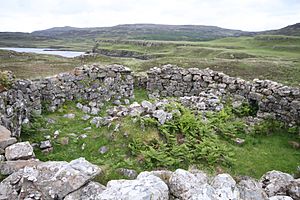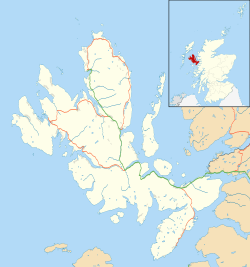Dun Fiadhairt facts for kids

Interior of Dun Fiadhairt
|
|
| Location | Skye |
|---|---|
| Coordinates | 57°27′34″N 6°37′07″W / 57.459331°N 6.618568°W |
| Type | Broch |
| History | |
| Periods | Iron Age |
Dun Fiadhairt is an ancient stone tower called a broch. It was built a very long time ago, during the Iron Age. You can find it on the northern coast of the Isle of Skye in Scotland. Brochs were special round towers built by people living in Scotland over 2,000 years ago.
Contents
Where is Dun Fiadhairt Located?
Dun Fiadhairt is about 3.5 kilometers (about 2 miles) northwest of a village called Dunvegan. It sits on the beautiful Isle of Skye. The broch is built on a small, rocky hill. This hill is surrounded by open moorland, which is a type of wild, open land. It's also on a piece of land that sticks out into Loch Dunvegan, a sea loch (a narrow inlet of the sea).
What Does Dun Fiadhairt Look Like?
This ancient tower is quite large! The outside of the broch measures about 16.8 meters (about 55 feet) across. The inside space is about 9.6 meters (about 31 feet) wide.
Main Entrance and Passages
The main way to get into Dun Fiadhairt is through an entrance on its west side. This entrance passage is about 3.7 meters (about 12 feet) long. Inside this passage, there are two small rooms, one on each side. These are often called "guard cells." People think they might have been used to control who came in or for storage.
Inside the Broch Walls
The inside of the broch has some interesting features. There's a special double room built right into the thick wall. Also, at the bottom of a staircase, there's another "guard cell." The rest of the inner wall has a passage at ground level. This passage is called a "mural gallery."
Interestingly, a door from this mural gallery goes right through the wall. It forms a small second entrance to the broch. Experts are not sure if this second entrance was part of the original design. Other brochs sometimes have second entrances, but they often seem to have been added later.
Who Explored Dun Fiadhairt?
Dun Fiadhairt was first explored and dug up around the year 1892. This work was done by a person known as Countess Vincent Baillet de Latour. Sadly, not much information was written down about what she found during these early digs.
However, about 20 years later, the Countess did another excavation at a different broch called Dun Beag. She was much more careful this time, and we have more details about that project.
What Was Found at Dun Fiadhairt?
During the excavations at Dun Fiadhairt, many interesting objects were discovered. These finds help us learn about the people who lived there long ago.
- Pottery: Many pieces of pottery were found, showing that people used pots and containers.
- Iron: A lot of "iron refuse" was also discovered. This suggests that people might have been working with iron there.
- Stone Tools: Stone items included a rotary quern, which was used for grinding grain into flour. A whetstone (for sharpening tools), a hammerstone (for hammering), and spindle whorls (used for spinning thread) were also found. There was even a piece of a stone armlet, which is like a bracelet.
- Beads: Several colorful glass beads were found. Even more exciting were 59 amber beads! These amber beads were shaped like short cylinders and likely formed a beautiful necklace.
- Clay Object: A baked clay object was also discovered. Some people think it might be a Roman votive model of a bale of wool. A votive model is a small item offered as a gift to a god or spirit.


